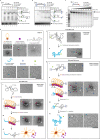Mre11-Rad50 oligomerization promotes DNA double-strand break repair
- PMID: 35501303
- PMCID: PMC9061753
- DOI: 10.1038/s41467-022-29841-0
Mre11-Rad50 oligomerization promotes DNA double-strand break repair
Abstract
The conserved Mre11-Rad50 complex is crucial for the detection, signaling, end tethering and processing of DNA double-strand breaks. While it is known that Mre11-Rad50 foci formation at DNA lesions accompanies repair, the underlying molecular assembly mechanisms and functional implications remained unclear. Combining pathway reconstitution in electron microscopy, biochemical assays and genetic studies, we show that S. cerevisiae Mre11-Rad50 with or without Xrs2 forms higher-order assemblies in solution and on DNA. Rad50 mediates such oligomerization, and mutations in a conserved Rad50 beta-sheet enhance or disrupt oligomerization. We demonstrate that Mre11-Rad50-Xrs2 oligomerization facilitates foci formation, DNA damage signaling, repair, and telomere maintenance in vivo. Mre11-Rad50 oligomerization does not affect its exonuclease activity but drives endonucleolytic cleavage at multiple sites on the 5'-DNA strand near double-strand breaks. Interestingly, mutations in the human RAD50 beta-sheet are linked to hereditary cancer predisposition and our findings might provide insights into their potential role in chemoresistance.
© 2022. The Author(s).
Conflict of interest statement
The authors declare no competing interests.
Figures






Similar articles
-
The characterization of Saccharomyces cerevisiae Mre11/Rad50/Xrs2 complex reveals that Rad50 negatively regulates Mre11 endonucleolytic but not the exonucleolytic activity.J Mol Biol. 2007 Sep 28;372(4):864-882. doi: 10.1016/j.jmb.2007.07.013. Epub 2007 Jul 21. J Mol Biol. 2007. PMID: 17698079
-
Processing of DNA double-stranded breaks and intermediates of recombination and repair by Saccharomyces cerevisiae Mre11 and its stimulation by Rad50, Xrs2, and Sae2 proteins.J Biol Chem. 2013 Apr 19;288(16):11273-86. doi: 10.1074/jbc.M112.439315. Epub 2013 Feb 26. J Biol Chem. 2013. PMID: 23443654 Free PMC article.
-
A Disease-Causing Single Amino Acid Deletion in the Coiled-Coil Domain of RAD50 Impairs MRE11 Complex Functions in Yeast and Humans.Cell Rep. 2020 Dec 29;33(13):108559. doi: 10.1016/j.celrep.2020.108559. Cell Rep. 2020. PMID: 33378670 Free PMC article.
-
ATP puts the brake on DNA double-strand break repair: a new study shows that ATP switches the Mre11-Rad50-Nbs1 repair factor between signaling and processing of DNA ends.Bioessays. 2014 Dec;36(12):1170-8. doi: 10.1002/bies.201400102. Epub 2014 Sep 11. Bioessays. 2014. PMID: 25213441 Review.
-
Structure-function relationships of the Mre11 protein in the control of DNA end bridging and processing.Curr Genet. 2019 Feb;65(1):11-16. doi: 10.1007/s00294-018-0861-5. Epub 2018 Jun 19. Curr Genet. 2019. PMID: 29922906 Review.
Cited by
-
HLTF disrupts Cas9-DNA post-cleavage complexes to allow DNA break processing.Nat Commun. 2024 Jul 10;15(1):5789. doi: 10.1038/s41467-024-50080-y. Nat Commun. 2024. PMID: 38987539 Free PMC article.
-
Sequence and chromatin features guide DNA double-strand break resection initiation.Mol Cell. 2023 Apr 20;83(8):1237-1250.e15. doi: 10.1016/j.molcel.2023.02.010. Epub 2023 Mar 13. Mol Cell. 2023. PMID: 36917982 Free PMC article.
-
Systematic Comparison of Commercial Uranyl-Alternative Stains for Negative- and Positive-Staining Transmission Electron Microscopy of Organic Specimens.Adv Healthc Mater. 2025 Jun;14(16):e2404870. doi: 10.1002/adhm.202404870. Epub 2025 Apr 29. Adv Healthc Mater. 2025. PMID: 40302369 Free PMC article.
-
Recruitment of Mre11 to recombination sites during meiosis.bioRxiv [Preprint]. 2025 Jul 8:2025.07.08.663703. doi: 10.1101/2025.07.08.663703. bioRxiv. 2025. PMID: 40672306 Free PMC article. Preprint.
-
The MRE11-RAD50-NBS1 complex both starts and extends DNA end resection in mouse meiosis.bioRxiv [Preprint]. 2024 Aug 17:2024.08.17.608390. doi: 10.1101/2024.08.17.608390. bioRxiv. 2024. Update in: Nat Commun. 2025 Apr 16;16(1):3613. doi: 10.1038/s41467-025-57928-x. PMID: 39185212 Free PMC article. Updated. Preprint.
References
Publication types
MeSH terms
Substances
LinkOut - more resources
Full Text Sources
Molecular Biology Databases
Research Materials
Miscellaneous

